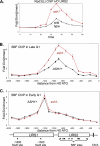Repressive chromatin affects factor binding at yeast HO (homothallic switching) promoter
- PMID: 21840992
- PMCID: PMC3186355
- DOI: 10.1074/jbc.M111.281626
Repressive chromatin affects factor binding at yeast HO (homothallic switching) promoter
Abstract
The yeast HO gene is tightly regulated, with multiple activators and coactivators needed to overcome repressive chromatin structures that form over this promoter. Coactivator binding is strongly interdependent, as loss of one factor sharply reduces recruitment of other factors. The Rpd3(L) histone deacetylase is recruited to HO at two distinct times during the cell cycle, first by Ash1 to the URS1 region of the promoter and then by SBF/Whi5/Stb1 to URS2. SBF itself is localized to only a subset of its potential binding sites in URS2, and this localization takes longer and is less robust than at other SBF target genes, suggesting that binding to the HO promoter is limited by chromatin structures that dynamically change as the cell cycle progresses. Ash1 only binds at the URS1 region of the promoter, but an ash1 mutation results in markedly increased binding of SBF and Rpd3(L) at URS2, some 450 bp distant from the site of Ash1 binding, suggesting these two regions of the promoter interact. An ash1 mutation also results in increased coactivator recruitment, Swi/Snf and Mediator localization in the absence of the normally required Gcn5 histone acetyltransferase, and HO expression even in the presence of a taf1 mutation affecting TFIID activity that otherwise blocks HO transcription. Ash1 therefore appears to play a central role in generating the strongly repressive environment at the HO promoter, which limits the binding of several coactivators at URS2 and TATA region.
Figures







Similar articles
-
Multiple Negative Regulators Restrict Recruitment of the SWI/SNF Chromatin Remodeler to the HO Promoter in Saccharomyces cerevisiae.Genetics. 2019 Aug;212(4):1181-1204. doi: 10.1534/genetics.119.302359. Epub 2019 Jun 5. Genetics. 2019. PMID: 31167839 Free PMC article.
-
SWI/SNF binding to the HO promoter requires histone acetylation and stimulates TATA-binding protein recruitment.Mol Cell Biol. 2006 Jun;26(11):4095-110. doi: 10.1128/MCB.01849-05. Mol Cell Biol. 2006. PMID: 16705163 Free PMC article.
-
Ash1 and Tup1 dependent repression of the Saccharomyces cerevisiae HO promoter requires activator-dependent nucleosome eviction.PLoS Genet. 2020 Dec 31;16(12):e1009133. doi: 10.1371/journal.pgen.1009133. eCollection 2020 Dec. PLoS Genet. 2020. PMID: 33382702 Free PMC article.
-
Daughter-specific repression of Saccharomyces cerevisiae HO: Ash1 is the commander.EMBO Rep. 2004 Oct;5(10):953-7. doi: 10.1038/sj.embor.7400251. EMBO Rep. 2004. PMID: 15459746 Free PMC article. Review.
-
Histone acetylation and deacetylation in yeast.Nat Rev Mol Cell Biol. 2003 Apr;4(4):276-84. doi: 10.1038/nrm1075. Nat Rev Mol Cell Biol. 2003. PMID: 12671650 Review.
Cited by
-
FACT and Ash1 promote long-range and bidirectional nucleosome eviction at the HO promoter.Nucleic Acids Res. 2020 Nov 4;48(19):10877-10889. doi: 10.1093/nar/gkaa819. Nucleic Acids Res. 2020. PMID: 33010153 Free PMC article.
-
Multiple Negative Regulators Restrict Recruitment of the SWI/SNF Chromatin Remodeler to the HO Promoter in Saccharomyces cerevisiae.Genetics. 2019 Aug;212(4):1181-1204. doi: 10.1534/genetics.119.302359. Epub 2019 Jun 5. Genetics. 2019. PMID: 31167839 Free PMC article.
-
PP2ARts1 is a master regulator of pathways that control cell size.J Cell Biol. 2014 Feb 3;204(3):359-76. doi: 10.1083/jcb.201309119. J Cell Biol. 2014. PMID: 24493588 Free PMC article.
-
A Role for Mediator Core in Limiting Coactivator Recruitment in Saccharomyces cerevisiae.Genetics. 2020 Jun;215(2):407-420. doi: 10.1534/genetics.120.303254. Epub 2020 Apr 23. Genetics. 2020. PMID: 32327563 Free PMC article.
-
Enhancement of LacI binding in vivo.Nucleic Acids Res. 2019 Oct 10;47(18):9609-9618. doi: 10.1093/nar/gkz698. Nucleic Acids Res. 2019. PMID: 31396617 Free PMC article.
References
Publication types
MeSH terms
Substances
LinkOut - more resources
Full Text Sources
Molecular Biology Databases

